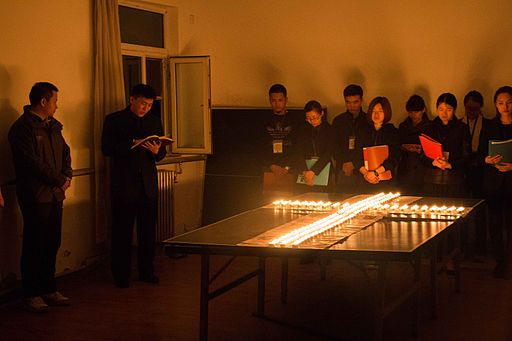GlobalPlus: Religion in China
The other Chinese miracle: Great awakening shifts growth of global Christianity to the East

Ancient Roman rulers claimed divinity for themselves, and tortured, imprisoned or killed leaders of a fledgling religious group they viewed as a threat to their empire.
But the group grew despite the persecution. After the Edict of Milan around 313 promoting tolerance and a deathbed conversion by Constantine 1, the roots were in place for Christianity to become the world’s largest religion.
Seventeen centuries later, a similar shift is taking place in an empire where an all-powerful ruler tried to drive out religion, and failed.
Today, China finds itself in the midst of a religious revival that is reshaping the global religious landscape in profound ways in the Third Millennium of the Christian era.
The well-documented rapid religious growth of Christianity in Africa and Latin America has largely overshadowed the spiritual transformation in the Global East.
But just think, for a moment, what has happened in the world’s most populous nation, which only 45 years ago attempted to eradicate all traces of religion from the land.
- From 1950 to 2010, the number of Christians in China increased from 4 million to 67 million.
- By 2030, China is projected to have some 225 million Protestant Christians alone, a figure similar to the entire Christian population today in the United States.
- The experience of Chinese Christians in South Korea and the U.S. indicates it is reasonable to expect the growth will continue at least until it reaches 30 percent of a population projected to reach 1.4 billion in the next 15 years.
From confounding expectations that sometime this century Islam may become the world’s largest religion to challenging Western theories of economic growth leading to the obsolescence of faith, China is in the midst of a great awakening that is transforming what once appeared to be the most secular nation on Earth to the leading edge of Christian expansion in the 21st century.
You may find all this surprising. At one time, I could not have imagined it.
A faith that would not die
There were no temples or churches in my village or the surrounding areas in the great plains of Hebei Province where I grew up.
God is dead. Religion is gone.
That was what we were taught in schools in China in the 1960s and 1970s. And it appeared true to this country boy who spent many of the school days learning rudimentary farming or conducting military training
with a wooden spear.
From rural to urban China, all temples, mosques, and churches were closed down between 1966 and 1979. Religious artifacts were smashed, religious buildings torn down or converted for other use, and religious clergy were forced to return to the secular life.
Only one object of worship was permitted: the Communist leader Mao Zedong.
Statues and portraits of Mao were ubiquitous, as were public rituals of homage toward them. We started the school day by chanting Maozhuxi wansui (Chairman Mao, live for 10,000 years) or Maozhuxi wanshouwujiang (Chairman Mao, live forever) toward Mao’s portrait on the front wall.
In the period of reform that followed, atheism remained official state policy, but the state gave up its effort to eliminate religion by any means and limited freedom of public worship and belonging to officially-sanctioned religious groups was allowed.
Yet many of the worshippers were older or members of ethnic minorities. The watershed moment in the Chinese great awakening would not come until the 1989 democracy movement and the June Fourth Massacre.
The religious floodgates were opened, meeting a wave of pent-up demand for spiritual expression outside the state.
The 2007 Chinese Spiritual Life Survey found that 85 percent of the population had some form of religious belief and practice, with many practicing some forms of folk religion.
About 18 percent identified as Buddhists.
But it was the Christians who have had the most remarkable growth. Hard numbers are difficult to come by since even today religious membership comes with a price that includes more limited social, political and economic opportunities. For those who worship outside state-approved churches, such as Catholics who choose the international Catholic Church over the Chinese Patriotic Catholic Association, the penalties can be much worse.
Still, research is affirming estimates that show Christians have experienced more than 10 percent annual compounded growth since 1980, and now make up somewhere between 5 percent to 10 percent of the population. That threshold is critical for a far-flung empire with vast regional and cultural diversity.
To return to the parallel with the Roman Empire, it was when the Christian population reached those significant numbers that officials started the Great Persecution early in the 4th century, only to change course a decade later with the Edict of Milan.
In an empire it is very hard to enforce any policy from the very top. As in ancient Rome, any effort to halt Christian growth in China at this point will fail. It is already beyond government control.
In China, becoming Christian is an unstoppable trend.
Seeds in fertile ground

One of the modern Chinese Christians who paid a steep price was Mr. Niu, a minister and recognized New Testament scholar in the 1950s until he was imprisoned for his faith. I first came to know him as a retired factory worker who came to Nankai University in the 1980s to teach us the Greek language as a volunteer. He told us that while he was in prison and in a labor camp, he became a socialist new man,
a sincere atheist and happy factory worker doing menial labor.
His calling, however, also proved unstoppable. Only a couple of years later, Mr. Niu moved to Beijing to teach at the newly reopened Yanjing Christian Seminary. In late 1988, I paid a visit to him at the seminary. By then, I had become a faculty member of religious studies in Beijing, and Mr. Niu had fully recovered his faith in Christ, with all the authentic and magnetic voice that I had known of this gentleman.
Mr. Niu represents many Chinese Christians who are able to more openly express their faith in the new China. The increase in social space with the more open state policies and factors such as globalization and the exposure to new ideas and systems of meaning are also an important part of attracting new converts.
For many Chinese, Christianity is associated with a modern society and modern values such as freedom and democracy.
What is also critical to Christian growth is the social context of modern China.
There is a widespread social anomie in China, a sense of alienation and personal and social unrest as people search for a coherent system of meaning that was once supplied by communism. Urbanization, the vast movement of rural populations to the cities, has exacerbated this sense of a loss of moorings they once found in the open doors and communal standards of village life. Locked in behind apartment doors in anonymous high-rise buildings, they are searching for new forms of communities and social support. And for a set of values that will support strong family life amid rising divorce rates.
Buddhism, with its emphasis on the individual and the lack of a tradition of providing social services and fellowship opportunities, is not well suited to meet those needs.
However, the Christian congregation, with widespread offerings to meet both the religious and social needs of members, is uniquely positioned to attract the present generation of Chinese. What I have seen in churches throughout China are major new ministries in areas such as pre- and post-marriage counseling.
In many areas, the celebration of Christmas has become a community festival, with church-sponsored events attracting people throughout the surrounding neighborhoods.
While research is just beginning to measure the impact of Christianity in China, reports from the field are consistent with the findings of hundreds of Western studies that religious involvement is in general related to better mental and physical health, and to positive outcomes in areas from stronger family structures to a lower likelihood of delinquent behavior in youth.
Even the new two-child policy in China can be expected to benefit Christians since individuals who have no religion or are Buddhists in general have lower fertility rates.
In Western nations such as the United States, many sociologists tend to view religious growth from the perspective of supply-side economics, where religious groups have to win newcomers from others by offering better services in a mature, competitive marketplace. In China, however, demand for the supply of religious goods – kept artificially low for so many decades – shows no signs of letting up.
In a nation where some 900 million people could be classified as religiously unaffiliated, demand may be set to explode.
Looking to the future
The headline on the press release read, Number of Muslims Worldwide Expected to Nearly Equal Number of Christians by 2050.
And inside, the generally excellent Pew Research Center report on global religious projections speculated Muslims may pull even with Christians by 2070 and even slightly surpass their numbers by the end of the century. It also projected Christianity would experience a net outflow of 66 million people among people switching belief systems.
Yet the report also projected the percentage of Christians in China would remain largely unchanged at a little more than 5 percent through 2050. That assumption is simply indefensible in light of what we now know.
It is hard to project too far into the future. But with the social factors in place, and a growing demand for religion that may be decades away from catching up to the available supply, increases along the lines of the 10 percent annual growth rate can be expected for the next decade or two.
At those rates, the number of Protestant Christians alone would grow to 418 million, or 30 percent of the total population, by 2030. Even if projections were scaled down to 7 percent growth, the Protestant Christian population would approach 450 million by 2040. Add in the Catholic population, and the growth projections accelerate.
What also makes such estimates seem likely is that other Asian nations have already experienced rapid Christian growth. South Korea, for example, is 30 percent Christian. Chinese communities in other nations have also experienced significant increases. About three in 10 Chinese Americans are Christian, and in Singapore the percentage of Chinese who are Christian reached 20 percent in 2010, and continues to grow.
If that can happen in those societies, it is more likely to happen in mainland China because the communists have already wiped out or severely damaged traditional religions and culture.
One sign of the advancing state of Christianity in China is that it is reaching out to the larger world. Nine hundred Chinese pastors gathered in Hong Kong this fall for the Mission 2030 Conference. Their goal: To send out 20,000 missionaries from mainland China by 2030.

They say that was about the total of Western missionaries who once worked in China, and that it is time for Chinese Christians to give back that many cross-cultural missionaries to the kingdom of God.
It may be a long while, if ever, before a Chinese premier, in the manner of the Roman Emperor Constantine, undergoes a dramatic conversion. Or the state makes Christianity its official religion.
However, what matters more in this movement that is on a path to grow a hundredfold since the middle of the 20th century are the conversions of ordinary citizens. People such as my father.
My father was a life-long staunch Communist Party member, who, like Constantine, was baptized on his deathbed.
During a cold winter many years earlier, he was riding a bicycle to cross a river on the ice. Suddenly the ice cracked in front of him and he tumbled into the river and slipped under the thick ice. Then, he said, he saw someone with a white garment guiding him to the hole in the ice so that he could climb out and get home. Was that Guanyin Bodhisattva or Jesus? He did not think about it until many years after his retirement. He decided that it was Jesus who saved him, leading to his baptism in the end.
Those decisions to become Christian, already taken by tens of millions of Chinese and projected to be embraced by hundreds of millions more, have implications far beyond China. For example, when you are talking about an additional 350 million to 400 million Christians, the numbers turn vastly in Christianity’s favor to remain the world’s largest religion and to report significant gains, rather than a net loss, among those switching religions.
In its earliest stages, a faith born in the East became the dominant religion in the West. To understand global Christianity at the beginning of the Third Millennium of its existence, one must again look to the East.
Resources
- ARDA National Profiles: View religious, demographic, and socio-economic information for China and all other Asian nations with populations of more than 2 million. Special tabs for each country also allow users to measure religious freedom in the selected nation and read the key parts of its Constitution referencing religion.
- ARDA Compare Nations: Compare detailed measures on religion in China, including religious freedom and social attitudes, with similar measures for up to seven other nations.
- Center on Religion and Chinese Society: Through its newsletter, research projects and scholarly exchanges, the goal of the center is to deepen understanding of Chinese religions.
- Spiritual Life Study of Chinese Residents: A state-of-the-art random sample of Chinese citizens assessing their religious and spiritual life.
- Review of Religion and Chinese Society. The review is an international peer-reviewed journal publishing articles and book reviews.
Religion
is understood in the broadest sense, including various spiritual and meaning-making systems of beliefs and practices.
Articles
- Xinping, Zhuo. Religion and Rule of Law in China Today.
The article provides an overview, with historical context, on laws and regulations on religion in China. - Qianfan, Zhang; Yingping, Zhu. Religious Freedom and Its Legal Restrictions in China.
The article explores issues of religious freedom. - Ying, Fuk-tsang, Yuan, Hao and Lau, Siu-lun. Striving to Build Civic Communities: Four Types of Protestant Churches in Beijing.
This study examines whether and to what extent Protestant churches contribute to the building of civic communities within China. - Yang, Fenggang. What about China? Religious Vitality in the Most Secular and Rapidly Modernizing Society.
Through a biographical and historical account of religious change in China, this article first offers a personal observation of life in a society without religion.
Books
- Froese, Paul. The Plot to Kill God: Findings from the Soviet Experiment in Secularization.
The book explores the nature of religious faith in the face of one of the most massive atheism campaigns in human history. - Luo, Guangwu. 1949–1999 Xin Zhongguo Zongjiao Gongzuo Dashi Gailan (A Brief Overview of Major Events of Religious Affairs in New China 1949–1999). Beijing, China: Huawen Press.
- Eds. Yang, Fenggang, Gao, Shining, and Li, Xiangping. Li (eds.). 2015. Tianye Guilai: Zhongguo Zongjiao he Zhongguo Shehui (Fieldwork and Beyond: Studies of Chinese Religion and Chinese Society), Volume 1.
Volumes 2 and 3 should be out by the end of the year. These three volumes represent the latest empirical studies of various religious phenomena in China today. - Yang, Fenggang. Religion in China: Survival and Revival under Communist Rule.
The book provides a comprehensive overview of religious change in China. - Yiwu, Liao. God is Red: The Secret Story of How Christianity Survived and Flourished in Communist China.
The author profiles the lives of dozens of Chinese Christians, providing a rare glimpse into the underground world of belief that is taking hold within the officially atheistic state of Communist China.
